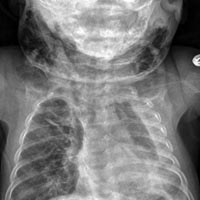 Smart Citations
Smart CitationsSee how this article has been cited at scite.ai
scite shows how a scientific paper has been cited by providing the context of the citation, a classification describing whether it supports, mentions, or contrasts the cited claim, and a label indicating in which section the citation was made.
Subcutaneous emphysema of the neck as a complication of high flow nasal cannula therapy in children: a case report
High Flow Nasal Cannula (HFNC) is a noninvasive technique for respiratory support increasingly used in the pediatric wards for the management of respiratory failure. Few data are reported about the safety of HFNC. We describe the case of a 3-months-old infant admitted for acute bronchiolitis Respiratory Syncyctial Virus-related and treated with HFNC for severe respiratory distress. 12 hours after the beginning of HFNC a subcutaneous swelling of the neck, attributable to subcutaneous emphysema, became clinically evident. Radiological imaging showed pneumomediastinum with air leaking up to the neck. Patient was moved to PICU where he further worsened due to a mediastinal shift requiring drainage and mechanical ventilation. He was then progressively weaned from ventilation and was discharged from the hospital. Pneumomediastinum may occur during HFNC, particularly in moderate-severe cases of acute bronchiolitis. Patients undergoing HFNC should be strictly monitored in order to promptly recognize this complication and treat the child appropriately.
How to Cite
PAGEPress has chosen to apply the Creative Commons Attribution NonCommercial 4.0 International License (CC BY-NC 4.0) to all manuscripts to be published.

 https://doi.org/10.4081/ecj.2021.9615
https://doi.org/10.4081/ecj.2021.9615





